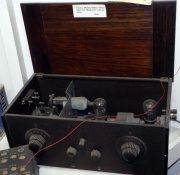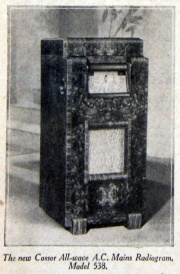A. C. Cossor: Difference between revisions
No edit summary |
|||
| Line 2: | Line 2: | ||
[[Image:Im20110714Amb-Cossor-MM.jpg|thumb| Cossor Melody Maker three-valve set. Exhibit at [[Amberley Working Museum]]. ]] | [[Image:Im20110714Amb-Cossor-MM.jpg|thumb| Cossor Melody Maker three-valve set. Exhibit at [[Amberley Working Museum]]. ]] | ||
[[Image:Im20110714Amb-i085.jpg|thumb| Early 1930s. Cossor Melody Maker Model 357. Exhibit at [[Amberley Working Museum]]. ]] | [[Image:Im20110714Amb-i085.jpg|thumb| Early 1930s. Cossor Melody Maker Model 357. Exhibit at [[Amberley Working Museum]]. ]] | ||
[[Image:Im20101014BCM-Cossor.jpg|thumb| ]] | |||
[[Image:Im20110714Amb-i100.jpg|thumb| 1936. Model A3764. Exhibit at [[Amberley Working Museum]]. ]] | [[Image:Im20110714Amb-i100.jpg|thumb| 1936. Model A3764. Exhibit at [[Amberley Working Museum]]. ]] | ||
| Line 9: | Line 10: | ||
[[Image:Im19381112PP-Cossor.jpg|thumb| November 1938.]] | [[Image:Im19381112PP-Cossor.jpg|thumb| November 1938.]] | ||
[[Image:Im20110714Amb-Cossor.jpg|thumb| Exhibit at [[Amberley Working Museum]]. ]] | [[Image:Im20110714Amb-Cossor.jpg|thumb| Exhibit at [[Amberley Working Museum]]. ]] | ||
[[Image:Im19390422pP-Coss.jpg|thumb| April 1939.]] | |||
[[image:Im19390318PP-Cossor.jpg|thumb| March 1939.]] | [[image:Im19390318PP-Cossor.jpg|thumb| March 1939.]] | ||
[[Image:Im1947MHI-Cossor.jpg|thumb| 1947. ]] | [[Image:Im1947MHI-Cossor.jpg|thumb| 1947. ]] | ||
Revision as of 15:49, 25 April 2012













of Cossor House, Highbury Grove, London, N5. Telephone: North 4340. Cables: "Amplifiers, London".
1859 The company was established by Alfred Charles Cossor in Clerkenwell, to manufacture scientific glassware.
1875 His eldest son, also called Alfred Charles Cossor joined the company, and he founded the A. C. Cossor electronics company.
The company's expertise in the manufacture of electrical glassware, such as early cathode ray tubes and X-Ray tubes, led the company to diversify into electronics.
1885 The younger son Frank Cossor joined the company, and eventually took over the running of the original scientific glassware company which remains to this day as Accoson, a manufacturer of sphygmomanometers.
1902 The company produced the first British made Braun tube.
1904 Experimental valves are produced by Cossor for Ambrose Fleming.
1908 A. C. Cossor left his father's business to found his own company.
WWI During the first world war the company was one of the first to produce valves in quantity for the war effort including large numbers of type R valves, a generic valve design produced by several other companies.
1918 The company moved to Highbury, to a factory called the Aberdeen Works. The office building which was called Cossor House, is still standing and now forms part of London Metropolitan University campus. Many of the buildings interior art deco furnishings remain untouched.
Post-WWI the company produced its first radio sets in kit form.
1924 Cossor introduced the first British valves to incorporate an oxide coated filament.
1926 Ceased manufacture of filament lamps[1].
1927 Company launched its famous "Melody Maker" radio set.
1929 Advert for Radio Receiving Valves. Also as makers of H. T. Eliminators; Trickle Chargers; L. F. Transformers; Loud Speakers; Motor Bulbs. Tuning Coils; Valve Holders; and complete kits of nparts for the construction of the "Cossor Melody Maker". Screened Grid Sets. Electric Lamps and Signs. (Wireless Section - Stand Nos. MM.31, MM.32 and MM.33)
1930 First British RF pentode valve was made by Cossor.
1932 Company introduced its first cathode ray oscilloscope.
1935 Cossor cathode ray tube was used in the Daventry Experiment for radar research, conducted using the BBC transmitter.
1936 Company sold its first television receiver.
1937 Receivers for the Chain Home primary radar system, the world's first radar air defence system, were built by Cossor.
Cossor remained pre-eminent in the development of the cathode ray oscilloscope with the introduction of a dual beam version of the instrument.
1937 Manufacturers of wireless valves and apparatus.
1938 Cossor became a public limited company.
1939 The company switched to war production.
Cossor became involved in the early development of airborne IFF radar.
1945 Secondary radar for air traffic control became a key area of development.
1945 The company's valve operations were concentrated in one unit which became the subsidiary Electronic Tubes.
1949 Cossor withdrew from valve manufacture when EMI acquired control of Electronic Tubes which continued to supply Cossor[2].
1949 EMI acquired control of Cossor
1953 Manufacturer of TV sets [3]
1958 Cossor sold its radio and television business to Philips.
1958 Company moved to Harlow.
1961 Cossor was acquired by Raytheon.
See Also
Sources of Information
- 1929 British Industries Fair Advert 228
- [1] Wikipedia
- 1961 Dun and Bradstreet KBE
- 1937 The Aeroplane Directory of the Aviation and Allied Industries
- ↑ http://www.competition-commission.org.uk/rep_pub/reports/1950_1959/fulltext/020c02.pdf
- ↑ http://www.competition-commission.org.uk/rep_pub/reports/1950_1959/fulltext/020c02.pdf
- ↑ Choosing your Television Set. Published by Freelance in 1953.

